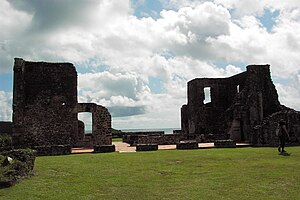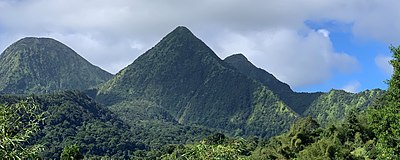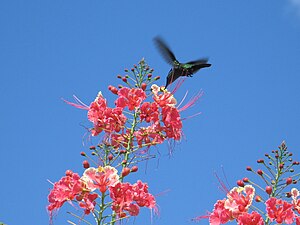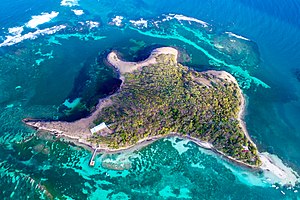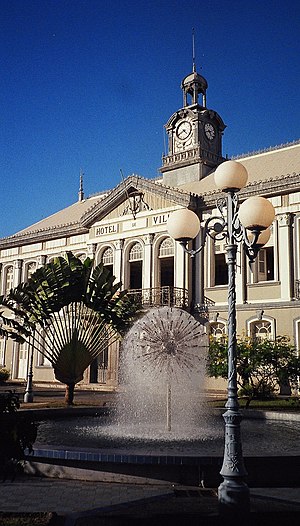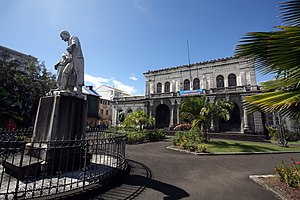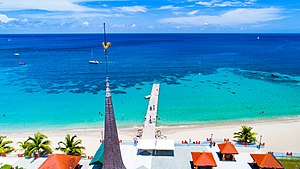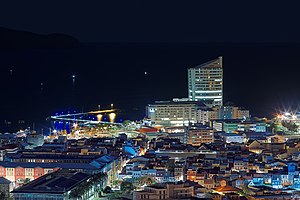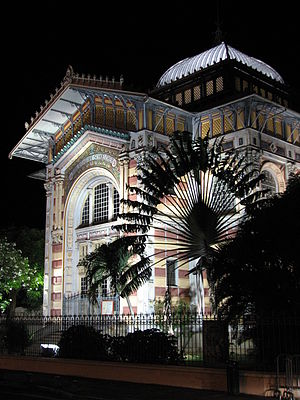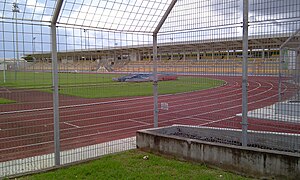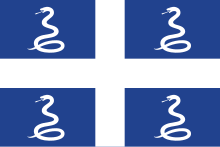Martinique
Martinique (in French, Martinique; in Martinique Creole, Matinik or Matnik) is an island with the status of region and overseas department of France, which is an integral part of the French Republic and of the European Union as an outermost region. As a unique territorial collectivity, it only consists of an assembly that regroups the powers of the regional and departmental Council. Although the nearby Guadeloupe overseas department is larger (it is made up of several islands), Martinique is the seventh largest island in the Antilles archipelago in the Caribbean Sea. It is located north of Saint Lucia and south of Dominica, in the Lesser Antilles. The official language is French, but the population also speaks Martiniqués Creole (créole martiniquais).
Etymology
It owes its name to Christopher Columbus, who conquered it starting in 1502. It was called Jouanacaëra-Matinino and was inhabited by the Caribs. This island belongs to the group of the so-called Lesser Antilles and within of this it belongs to the group of the so-called Windward Islands. It belongs to France since 1635. It is mountainous and of volcanic origin.
History
Pre-Columbian Period
The Lesser Antilles are believed to have been inhabited between 10,000 and 5,000 BCE. C., but there is no evidence of this to date. The oldest traces of human beings in the Lesser Antilles are found at the Norman Estate site, in Saint-Martin, and are dated between 2400 and 1900 BC. C. The first traces of Amerindians in Martinique have been archaeologically attested in the I century.
These first inhabitants come from the Amazon and are from the Saladoid culture, named after the homonymous Venezuelan site of Saladero. They are generally referred to as Arawak, although this imprecise term refers more broadly to a language family to which many Amerindian populations in the Amazon belong, including the Kali'na or Carib populations.
This highly decorated pottery-producing population mainly occupied the foothills of Mount Pelee. They practiced agriculture, fishing and gathering. The archaeological site of Vivé, in the commune of Lorrain, is characteristic of this first occupation of the island. This coastal settlement was excavated between 1996 and 2001. It is also at the center of a discovery and research project carried out by the Community of Municipalities of Northern Martinique.
European Colonization
Christopher Columbus was the first European navigator to reach the island on June 15, 1502. But, except on three occasions (1762-1763, 1794-1802 and 1809-1815) when it has been occupied by the British Empire, the island has remained under French rule since its colonization in 1635. Martinique is dominated by the 1,397 m a.s.l. volcano Mount Pelée. no. m., which erupted on May 8, 1902 during the so-called Martinique Cataclysm, completely destroying Saint Pierre, the first European settlement on the island, and killing more than 30,000 people. The population has been recovering since then, and today the island is one of the most populated in the region.
Marie-Josèphe Rose Tascher de la Pagerie, known as Josephine de Beauharnais, who married Napoleon I Bonaparte for the second time, was born on a Martinican slave plantation owned by her family called La Pagerie. Her second husband was responsible for reestablishing slavery on the island from 1794, which is why her image on the island continues to be very negative. The statue that represents her in Fort-de-France, has been beheaded several times.
During the first decades of the French occupation, the main source of the island was the production of food, such as tobacco, indigo, cocoa. The tobacco crisis of the second half of the 17th century led to the ruin of the first plantations, as well as the production of sugar.
Sugar Production
Sugar cane monoculture was part of the landscape and Creole culture that dominated the economy until the second half of the 20th century. This crop was carried out by the African slaves that were brought to the island, and they had the nickname of the “thirty-three”. The cultivation of sugarcane gave rise to the development of triangular trade (Europe, Africa, America), thus causing a rapid influx of the African slave population to the French possessions in America.
At the request of the American Islands Company, the Rouen merchant, of Dutch origin, Daniel Trézel installed the first sugar mill in Martinique in 1640, three years after Peter Blower did the same on the English island of Barbados. Jacques Dyel, Governor of the Parquet, would make full use of this contribution a decade later, in 1650, when the Company of the American Islands went bankrupt and bought it back for 41,500 francs.
In 1654, according to the testimony of Antoine Biet, on his return from Guyana, the Dutch fleeing from Brazil were welcomed instead in Guadeloupe, from where he recounted the return of three ships from Brazil, which the Dutch had just abandoned permanently after ten years of fighting against the Portuguese, the Dutch period of Pernambuco's history.
"There were about 1,200, of whom there were not even 50 natural Dutch, all the rest were mixed-race or black slaves who "wanted to continue" to his masters, he wrote in 1664, ten years later, in indirect testimony, the only one from the passage of the Dutch, which is questionable because Governor Houel needed to legitimize the development of slavery.
In Brazil, Portuguese planters rose up against the Dutch as early as 1642, and Fernandès Vieira won two important battles in 1645. In 1636, the first slaves were all sold on credit, but in 1644 and 1645, the proportion sold on cash rose to 78% and 100% respectively, reflecting the apprehension of the Dutch, who felt that Brazil would soon be taken from them.
The Dutch empire was quickly driven out in the second half of the 17th century, by fighting between the British and French. All the great European conflicts were to dominate the Caribbean. Martinique was a British possession, but for relatively short periods. It becomes French territory after 1816.
Conflicts with the Caribbean Indians
The settlement and expansion of the French created tensions and ongoing conflict with the natives. With the death of Governor de Parquet, the war of 1658 against the Indians of the Caribbean broke out.
More than 600 French met with the blessing of the priests of the island to attack the Caribs in their territories reserved by the peace agreement of December 21, 1657, with the intention of eliminating all indigenous presence on the island. The Caribs were massacred and lost the last territories reserved for them. The survivors took refuge on the islands of Saint Vincent and Dominica. From there, they will organize several punitive expeditions against the colonists of the neighboring islands.
This victory spurred French colonization to the east, led by Pierre Dubuc de Rivery, who founded a dynasty of sugar planters. He organized a militia in the city of Trinidad to repel the Caribs, and in 1671 he was granted land to clear, from the Caravelle peninsula to the city of Trinidad. The du Buc family built 7 sugar factories there. In 1671, sugarcane was still underdeveloped in Martinique: it occupied half the land of tobacco cultivation, practiced by many small white settlers, on plantations that required very little capital.
The Amerindians were gradually pushed out or driven out. However, a fringe of this "Caribbean" he remained in the area in a strong state of acculturation, gradually mixing with the rest of the population.
Slavery and freedom
Father Labat describes the slaves of the 17th century in his books. Once released, they own parcels of land. The wealthy planters seek new, cheaper labor, building on the success of the Barbados sugar planters. The cultivation of sugar in Martinique was tried from 1640, inspired by the success of Barbados, but without success. The explosion in the number of slaves reflects one of the major decisions taken at Versailles by Louis XIV between 1671 and 1674 to promote the cultivation of sugar, to the detriment of tobacco. Between 1674 and 1680, the number of slaves in Martinique doubled, and between 1673 and 1700, it increased six-fold.
The number of slaves in 1664 had decreased on both islands. Guadalupe authorized the arrival of more slaves from the 1640s onwards as long as they were controlled by a single owner; around 1660 there were about 6,000 slaves twice as many as Martinique, which had about 3,000 and who worked twice as much.
In France, in 1788, on the eve of the French Revolution, Brissot founded the Society of Friends of Negroes, but despite the efforts of its most prominent members, such as Abbot Grégoire, or Condorcet, he was unable to obtain the abolition of slavery with the Constitution. Only on February 4, 1794, the Convention abolished slavery, a measure not applied to all French possessions at the time.
In Martinique it will remain a dead letter, against Guadeloupe because a group of monarchist colonists under the leadership of Paul-Louis Dubuc, had a pact with the British, who occupied the island from 1794 to 1802.
On February 19, two weeks after the island's large plantations were abolished, the British signed the Treaty of Whitehall: in exchange for domination of the island and the lucrative tax on sugar, they agree to maintain slavery. The Treaty of Amiens (1802) returned the island to the First French Republic.
On February 24, 1809, it was reoccupied by the British, who held the island until the Treaty of Paris in 1814.
In 1848, the population of Martinique was 121,130 inhabitants, divided as follows: 9,542 whites, 38,729 freedmen and 72,859 slaves.
Eruption of Mount Pelée in 1902
Mount Pelée (French: 'Monte Pelado') is a 1,397 m s stratovolcano. no. m. which is in a state of activity in the north of the island. It is composed of extremely viscous magma and remnants of volcanic ash and solidified lava. It is characterized by having had infrequent activity, but with extremely violent eruptions, since the andesite present in the lava from the depths of the volcano has a high silica content, which is very viscous. In 1902, one of these eruptions completely destroyed the city of St. Pierre.
On May 8, 1902, light was seen at the top of the volcano and then a dense cloud of black smoke, followed by another mushroom-shaped cloud visible 100 km away. The initial speed of the two clouds was later calculated to be 670 km/h. A lava flow came down the slopes of the volcano at considerable speed, reaching the city within a minute, setting it on fire. Finally there was a precipitation with torrents of mud, which completely destroyed it. For hours all communication was cut off.
On May 20, Mount Pelée exploded again with even more violence, but this time without leaving any more victims.
Consequences of the eruption
The consequences from the social, political and economic point of view in Martinique were considerable. The eruption caused nearly 30,000 deaths and completely destroyed the city and its port. It was agreed that the city of Fort-de-France would replace Saint Pierre as the capital. Many children became orphans, hence the creation of the Hope orphanage in Fort-de-France. Finally, part of the affected population was relocated to other cities of Martinique in the North Atlantic and the south of the island. Others went to Guadeloupe, Saint Lucia, French Guiana, Panama, and Venezuela.
It would take at least four days for help to arrive from Fort-de-France by sea, only to rescue the four surviving people (two of whom would die soon after) and leave the ruins of the charnel-city. The cone of the volcano had disappeared for at least 300 m, leaving only a spindle column-shaped geological feature about 300 m high that later collapsed after the second eruption.
20th century
In 1932 the first plane landed, on the route between Cayenne and Antigua. In 1946 it became an Overseas Department.
Colonization succeeded slavery until 1946. Postwar communist leaders Aimé Césaire, Léopold Bissol and Georges Gratiant win electoral victories in Martinique. They submitted a bill to the National Assembly. The issue was debated in Parliament, with an illustrious speaker, the young deputy mayor of Fort-de-France, Aimé Césaire. This parliamentary debate led to the vote on the departmentalization law of March 19, 1946, the date on which the island became a French overseas department.
In 1950, the Fort-de-France airport was opened.
In 1962 the first demand for independence was produced around the Manifesto of the O.J.A.M (Organization of Anti-Colonial Youth of Martinique). The authors are eighteen students, who are locked up for political reasons and released only after two years of trial.
In 1983 it became a region, and Aimé Césaire was elected President of the Regional Council. In 1997, the independentist Alfred Marie-Jeanne was elected deputy of Martinique, who in 1998 became President of the Regional Council.
21st century
In 2005, 160 passengers died in the crash of a plane belonging to the Colombian company West Caribbean, most of them Martinicans. In 2008, Aimé Césaire died at the age of 94.
Autonomy
In a referendum held on January 10, 2010 at the request of local elected officials, 78.90% of Martinique's voters rejected the increase in autonomy provided for in article 74 of the French Constitution.
35 On January 24, 2010, a second vote was held (with 68.30% votes in favor and 64.19% abstention) to approve the creation of a single community in Martinique governed by article 73 of the Constitution. The first election of the members of the new Assembly of Martinique took place in December 2015.
Geography
It has a total area of 1,100 km², ranking third after Trinidad and Guadeloupe in the chain of islands that make up the Lesser Antilles. Martinique is 65 km long by 27 km wide. For comparative purposes, its area is similar to that of Hong Kong.
Like the rest of the Lesser Antilles, Martinique is subject to seismic risk. On November 29, 2007, an earthquake measuring 7.3 on the Richter scale occurred off the island.
Martinique is divided into two zones. On the one hand, one located to the north of the axis between Fort-de-France and Le Robert, an area that is the result of erosion due to the heavy rains caused by the sea made by evaporation of the trade winds, the highs of the Newly formed volcanoes to the north of the island, such as Mount Pelée (with 1,397 m a.s.l.) and the peaks of Carbet (1,196 m a.s.l.), to the south the rounded tops and steep slopes from an altitude of between one hundred and three hundred meters. In the south, there is an area with less relief, less abundant vegetation, drier climate, which includes most of the island's tourist facilities.
Relief
The terrain is mountainous on this island of volcanic origin. The oldest zones correspond to the volcanic zones in the extreme south of the island and towards the peninsula of La Caravelle towards the east. The island has developed in the last 20 million years according to a sequence of movements and eruptions of volcanic activity to the north. A volcano, still active, is Mount Pelée, located in the north of the island today and with a height of 1,397 m s. no. m., the last eruption dates back to May 8, 1902, claiming the lives of 29,000 people in 2 minutes. Vauclin Mountain is the highest point in the south of the island at 504 m. In the center are the plains and coastal areas, separated by steep slopes.
The east coast, coast of the wind or of the Islands, has been called cabesterre in the Caribbean. The term cabesterre in Martinique designates more specifically the area of La Caravelle. This windward coast, bordered by the Atlantic Ocean, is directly exposed to the trade winds and the swell. The northern part of the Grand River at Sainte-Marie is basically surrounded by cliffs with very few mooring points and access to sea navigation is limited to inshore fishing with small traditional Martinique boats
Hydrography
The island has a small hydrographic network, due to its geographical and morphological characteristics it has short and torrential rivers. The main ones are: The Lézarde, 30 km long, the longest on the island. To the North are: Galion, Lorrain, Hood, Blanco, Baja Pointe, Hackaert River, Macouba, La Grande, Prêcheur, Roxelane, Padre River, Carbet River. To the Center: the river Monsieur, Madame, Longvilliers. To the south: the Río Salado, Vauclin, Paquemar, Simon, and La Nau.
Climate
There are two marked seasons on the island, related to rain: the rainy season (hivernage in French) from May to November and the dry season (called carême in Martinique) from February to April. The dry season is normally a period of high heat and drought. As it usually begins after Carnival, it is called carême which means Lent. During the rainy season the humidity is very high and waves and tropical depressions are very frequent, causing whole weeks of rain.
In practice, fluctuations in the dates of each period are very frequent. The wet season is longer or shorter depending on the year. Sometimes there are late or early wet seasons, or very dry or very rainy carêmes. The average rainfall is 80 mm of rain in March in Lamentin (central plain located in the bay of Fort-de-France) and 260 mm of rain in October. The trade winds blow from the northeast to the east during most of the year, increasing during the morning and decreasing during the afternoon, decreasing during the nights.
The climate of Martinique is regulated by the position of the Azores anticyclone, which directs the northeast trade winds, and also by the position of the equatorial low pressure area, where the northern hemisphere winds meet those of the northern hemisphere. south along the intertropical convergence zone.
The average annual temperature is 26 °C. The hottest months are March, April, May, while the coldest months are December and January. The warmest temperature was recorded in "Saint Pierre" with 37 °C in April and May 1986 and the lowest around 12 °C in Saint-Denis in March 1965. There is an average of six days per year with a temperature lower than 18 °C in Lamentin.
| Month | Ene. | Feb. | Mar. | Open up. | May. | Jun. | Jul. | Ago. | Sep. | Oct. | Nov. | Dec. | Annual |
|---|---|---|---|---|---|---|---|---|---|---|---|---|---|
| Temp. max. abs. (°C) | 31.5 | 32.1 | 33.6 | 33.0 | 33.9 | 33.6 | 33.6 | 33.0 | 33.8 | 33.0 | 32.1 | 31.3 | 33.9 |
| Average temperature (°C) | 27.5 | 27.8 | 28.5 | 29.4 | 29.8 | 29.5 | 29.5 | 30.0 | 30.3 | 30.0 | 29.0 | 28.1 | 29.1 |
| Temp. medium (°C) | 21.9 | 21.7 | 22.0 | 22.8 | 23.6 | 24.0 | 23.9 | 24.0 | 24.0 | 23.8 | 23.4 | 22.6 | 23.1 |
| Temp. min. abs. (°C) | 17.8 | 17.3 | 18.6 | 18.9 | 19.9 | 20.0 | 18.4 | 19.5 | 17.9 | 20.2 | 19.7 | 17.4 | 17.3 |
| Total precipitation (mm) | 119.5 | 77.8 | 74.3 | 94.0 | 131.5 | 159.8 | 219.3 | 254.7 | 234.5 | 265.9 | 254.5 | 134.7 | 2020.5 |
| Precipitation days (≥ 1 mm) | 18.93 | 13.60 | 12.77 | 11.50 | 12.70 | 16.43 | 20.00 | 19.57 | 17.90 | 18.17 | 19.00 | 17.60 | 198.17 |
| Hours of sun | 203.6 | 198.5 | 223.8 | 211.3 | 208.1 | 191.0 | 200.7 | 224.5 | 206.1 | 182.9 | 184.4 | 201.8 | 2436.8 |
| Source: Meteo France | |||||||||||||
Hurricanes
The western zone is subject to the development of cyclones. Depending on the time of year, these depressions are in the Atlantic (Cape Verde) or the center of the Caribbean Sea and the Gulf of Mexico (west of the 80th meridian). Martinique is in the path of hurricanes.
Hurricane Dean caused significant damage to banana and sugarcane plantations in August 2007, with wind gusts reaching up to 167 km/h. Torrential rains caused numerous floods, especially in the town of Riviere-Pilote. One third of the total population of Martinique remained without electricity service. The authorities reported the death of a 90-year-old man due to a heart attack, but it was not confirmed that this was related to the impact of the storm.
More than 5,000 houses were destroyed and only public subsidies allowed the reconstruction. The residents of Martinique received financial aid from the metropolis and national support, especially from French representatives such as the Prime Minister or the Minister of Overseas Territories.[citation needed]
On the other hand, the Great Hurricane took place between October 10 and 16, 1780. It is estimated that some 22,000 people died then, many of them on the high seas. This hit the islands of Martinique, Saint Eustatius and Barbados. Fatalities from this hurricane far exceed those of any other hurricane in the Atlantic. In fact, the numbers exceed those accumulated in any year and in all other decades.
Flora and fauna
The jungle is made up of ferns and mahogany or courbaril trees, which are used to make furniture. Some can reach 45 meters in height. The tropical dry forest is composed of drought-tolerant plants adapted to it. In its degraded form or in extreme conditions the ground vegetation can take the form of the savannah.
Terrestrial fauna
Martinique has few native animal species. The most common wild animals are: the manikous (family of opossums), the matoutous-falaises which are endemic miguals, the iguana delicatissima and the green iguana, the mongoose, the tricephalous snake or spearhead and the scolopendras.
In the part of flying animals, Martinique is the country of herons, hummingbirds (4 species in Martinique: the Madeira hummingbird, the crested hummingbird, the green hummingbird and the blue-headed hummingbird) and sugarbirds (recognizable by their yellow belly).
On land, mongooses were imported in the late 19th century to reduce the population of spearhead snakes (or Trigonocephalus). Unfortunately, the consequences were severe, as the mongooses also destroyed many endemic bird species that are now completely extinct. Nowadays, it is easier to find many snakes and some small and harmless green lizards, the anoles and the mabouyas.
Two species of mygales coexist:
- Acanthoscurria antillensis is a land megalo that lives in southern Martinique, from Rivière-Pilote to Cap-Chevalier to Trois-Îlets;
- The Caribbean versicolor is an arboreal megalo that lives in northern Martinique, in the rainforest from Précheur to Grand'Rivière. This species, relatively quiet and unaggressive, is protected locally.
Aquatic fauna
The Atlantic coast is bordered by a practically uninterrupted coral reef, where fish from the open sea circulate and sedentary fauna take refuge.
The Atlantic coast is bordered almost uninterruptedly by coral reefs, a great refuge for wildlife and sedentary fish. The aquatic environment has deteriorated in the last twenty years. Industrial pollution, including distilleries, lack of wastewater treatment, intensive filling of mangrove areas, nurseries for many fish species and intensive fishing are the cause of considerable regression of the reef surface and a decrease in the number and variety of fish.
On land, imported mongooses to reduce the molting rattlesnake population are on the rise. The consequences are serious since they in turn attack many species of birds, constituting a serious threat to the conservation of bird life.
However:
- Since Hurricane Lenny in 1999, no cyclic mare has been strong enough to seriously damage the reefs. These years of relative calm have given time to submarine fauna and flora to recover;
- The installation of anchored fish aggregators away from the coast, often at a depth of 3,000 meters, has the effect of encouraging local fishermen to carry their supplies to the high seas, due to the best profitability, and thus alleviate the reefs of the overfishing activity.
Vegetation
Rainforest
The rain forest of Martinique, of the humid tropical or equatorial type, is made up of ferns and trees such as mahogany and courbaril, which are used to make furniture. Some of them can reach 60 meters in height. Numerous flowers from the Heliconiaceae family populate the undergrowth and are highly appreciated by florists due to their atypical shapes and striking colours. These flowers gave their name to Martinique (Madinina in Amerindian), which means "the island of flowers" in the language of the Carib Indians.
In the tropical rainforest, only 1% of sunlight reaches the young shoots on the ground through the canopy, so they do not develop. It isn't until a tropical cyclone knocks down the big trees that the young shoots can receive the solar energy they need to grow. For this reason, tropical cyclones are essential for the regeneration of the tropical forest and are part of the biological cycle of the island.
The tropical dry forest is made up of xerophytic plants adapted to a very dry climate (acacia, campèche, pear, red gum tree) and fatty plants (cactus, agave).
In the high mountains, above about 900 meters, the almost permanent strong winds and the temperature between 0 °C and 15 °C do not allow tropical vegetation to thrive. Therefore, this is replaced by a subtropical vegetation of height, adapted to extreme conditions: dwarf trees, Bromeliaceae and dwarf Araucariaceae (small conifers that do not exceed 20 centimeters in height) make up most of the vegetation cover..
In its degraded form or in extreme soil conditions, vegetation can also take the form of savannah, where cacti and succulents share the soil with wild grasses.
Mangroves
The mangrove is present throughout Martinique:
- Caravelle Peninsula (presqu'île de la Caravelle(natural reserve);
- Génipa Bay - Ducos;
- Bahia des Anglais - Sainte-Anne.
The Strelitziaceae, including the traveler's tree, were imported from South America and the Indian Ocean. Some palms are endemic to the island, such as Acrocomia or Roystonea, while others have been imported from other continents (especially Asia or Oceania), such as Cyrtostachys or Cocos nucifera. There are also many fruit trees on the island (avocado, breadfruit, tamarind, cythro plum).
Beaches
Martinique has numerous beaches: those in the south of the island have white sand, unlike those in the north, which are of volcanic origin and therefore have black or gray sand.
Most of the beaches are wild, without services and without surveillance, but some are organized and give the possibility of doing sports and activities related to the sea.
Southern Caribbean Beaches
- Les Salines
- Point du Marin
- Pointe des Salines
- Anse Meunière
- Anse Mabouyas
- Great Anse
- Anse Dufour
- Anse Noir
- Anse Mitan
- Anse à l'Ane
South Atlantic Beaches
- Anse Trabaud
- Anse Michel
- Anse Au Bois
- Anse Esprit
- Ilet Chevalier
- Anse Baleine
- Anse Grosse Roche
- Grand Macabou
- Gli Ilets di François
North Caribbean Beaches
- Anse Couleuvre
- Anse Céron
North Atlantic Beaches
- Tartane and Anse L'Etang
- Anse Bonneville
- Anse Charpentier
Politics and Administration
Current state of the island
Martinique is divided into four districts and thirty-four municipalities.
The "Territorial Collectivity of Martinique" is since December 18, 2015 a territorial collectivity of the French Republic governed by article 73 of the Constitution. The territorial collectivity of Martinique is also one of the outermost regions of the European Union.
Representation of the State
The prefecture of Martinique is Fort-de-France. The three sub-prefectures are Le Marin, Saint-Pierre and La Trinité. The French State is represented in Martinique by a prefect (Stanislas Cazelles since February 5, 2020)37 and by two sub-prefects in Le Marin (Corinne Blanchot-Prosper) and La Trinité / Saint-Pierre (Nicolas Onimus, appointed on 20/ 05/202038).
The prefecture was criticized for racism after the publication on its Twitter account of a poster calling for physical distancing against the coronavirus and in which a black man and a white man appeared separated by pineapples.
Institutions
The President of the Executive Council of Martinique is Serge Letchimy since July 2, 2021.
The Executive Council of Martinique is composed of nine members (one president and eight executive councillors)
The deliberative assembly of the territorial community is the Assembly of Martinique, made up of 51 elected members and chaired by Lucien Saliber since July 2, 2021.
The advisory council of the territorial collectivity of Martinique is the Economic, Social, Environmental, Cultural and Educational Council of Martinique (Conseil économique, social, environnemental, de la culture et de l' éducation de Martinique), made up of 68 members. Its president is Justin Daniel since May 20, 2021.
National representation
Martinique is represented since June 17, 2017 in the National Assembly by four deputies (Serge Letchimy, Jean-Philippe Nilor, Josette Manin and Manuéla Kéclard-Mondésir) and in the Senate by two senators (Maurice Antiste and Catherine Conconne) since September 24, 2017.
Martinique is also represented on the Economic, Social and Environmental Council by Pierre Marie-Joseph since April 26, 2021.
Administrative division
Martinique is divided into four municipalities, thirty-four communes, and forty-five cantons. With Guadeloupe and French Guiana it is one of the French Departments of America (DFA). It is also an outermost region of the European Union.
The four districts of the island, with their respective locations, are as follows
- Fort-de-France is the only prefecture of the department. It occupies the central area of the island. It comprises four communes and sixteen cantons. The district population was 163,969 in 1990. In addition to the capital, it includes the towns of Saint-Joseph and Schoelcher.
- The Trinité is one of the three subprefectures of the island. It is located in the northeastern area of Martinique. He has ten communes and eleven cantons. The population of the district was 78,922 in 1990 and 8,506 in 1999, with a population growth of 7.71%. In addition to the subprefecture, it is composed of the localities of L'Ajoupa-Bouillon, Basse-Pointe, Le Gros-Morne, Le Lorrain, Macouba, Marigot, Le Robert and Sainte-Marie.
- Le Marin is another Martinique subprefecture. It comprises the southern area of the island and consists of twelve communes and thirteen cantons. The district ' s population was 93,345 in 1990 and 106,818 in 1999, resulting in a strong population increase of 14.3%. In addition to Le Marin, it comprises the towns of Les Anses-d'Arlet, Le Diamant, Ducos, Le François, Rivière-Pilote, Rivière-Salée, Sainte-Anne, Sainte-Luce, Saint-Esprit, Les Trois-Îlets and Le Vauclin.
- Saint-Pierre is the third subprefecture of the department. It comprises eight communes and five cantons, occupying the north-west area of the island. Its population was 23,336 in 1990 and 23,464 in 1999, with a slight population increase of 0.55%. Next to Saint-Pierre, their localities are Le Carbet, Case-Pilote-Bellefontaine, Le Morne-Rouge and Le Prêcheur.
The communes are the cities, and the cantons are used for elections, they are a subdivision of the communes and they are to elect someone who represents three or more neighborhoods.
Institutional and statutory evolution of the island
During the 2000s, the political debate in Martinique focused on the question of the evolution of the island's status. Two political ideologies confront each other, assimilationism and autonomism. On the one hand, there are those who want a change of status based on article 73 of the French Constitution, that is, that all French laws are applied in Martinique with full rights, which in law is called legislative identity, and on the other side the autonomists who want a change of status based on article 74 of the French Constitution, that is, an autonomous status subject to the regime of legislative specialty following the example of Saint Martin and Saint Bartholomew.
Since the constitutional review of March 28, 2003, Martinique has four options:
- First possibility: the status quo, Martinique maintains its status as the Overseas Department and Region, under article 73 of the Constitution. The DROMs are under the legislative identity regime. In this context, laws and regulations are fully applicable, with the adaptations required by the particular characteristics and limitations of the affected communities.
- Second possibility: if local actors, and first of all elected representatives, agree, they may, within the framework of article 73 of the Constitution, propose institutional developments such as the creation of a single assembly (fusion of the general council and the regional council). However, the department and the region will remain. The Government may propose to the President of the Republic to consult the voters on this issue. In case of a negative response, nothing will be possible. In the event of a positive response, the final decision will be taken by Parliament, which will finally decide whether the reform is carried out through the adoption of an ordinary law.
- Third possibility: the elect may propose the creation of a new collectivity within the framework of article 73 of the French Constitution. This new community will replace the department and the region. It will bring together the competencies currently attributed to the General Council and the Regional Council. This community governed by article 73 is subject to the legislative identity regime and is therefore not autonomous. It will have as institutions an executive council, a deliberative assembly and an economic and social council.
- Fourth possibility: if a consensus is reached, the elected representatives may propose to the government a change of status, that is, the transformation of Martinique into an overseas collectivity (COM). In fact, since the constitutional review of 28 March 2003, overseas departments can, under article 74, become an overseas collectivity (COM) such as San Martín and San Bartolomé.
- Unlike overseas departments, overseas communities are subject to legislative specialization. The laws and decrees of the Republic apply to them under certain conditions established by the organic law that defines its statute. The Overseas Departments have a greater degree of autonomy than the DOMs. They have an executive council, a territorial council and an economic and social council. The prefect is the representative of the French State in the overseas collectivity.
However, the French Constitution specifies in article 72-4 that "no change may be made, for the whole or part of one of the communities mentioned in the second paragraph of article 72-3, of one to another of the regimes provided for in articles 73 and 74, without having obtained the prior consent of the voters of the community or of the part of the community in question, under the conditions provided for in the following paragraph.
In 2003 a new organization is expected, in which the regional institution and the departmental institution would be merged into a single institution. This proposal was rejected in Martinique (but also in Guadeloupe) by 50.48% in a referendum held on December 7, 2003.
On January 10, 2010, a public consultation was held. Voters were asked to vote in a referendum on a possible change to the status of their territory. The ballot proposed to voters to "approve or reject the transition to the regime provided for in article 74 of the Constitution." The majority of voters, 79.3%, said "no".
On the following January 24, in a second referendum, 68.4% of the population of Martinique approved the move to a "single collectivity" under article 73 of the Constitution, that is, a single assembly that would exercise the powers of the General Council and the Regional Council.
New community of Martinique
The project of the elected representatives of Martinique to the government proposes a single territorial community governed by article 73 of the Constitution, whose name is "Territorial Community of Martinique". The single assembly that replaces the General Council and the Regional Council is called the "Assembly of Martinique". The Assembly of Martinique is made up of 51 councillors, elected for a six-year term by the proportional representation system (the electoral constituency is divided into four sections). A 20% majority bonus is awarded to the first-placed list.
The executive body of this community is called the "executive council," which is made up of nine executive councilors, including a president. The president of the community of Martinique is the president of the executive council. The executive council is accountable to the Assembly of Martinique, which can overrule it by means of a constructive motion of no confidence. Unlike the previous functioning of the General Council and the Regional Council, the Martinique Assembly is separate from the Executive Council and is led by a bureau and a president.
The new collectivity of Martinique combines the powers of the general and regional councils, but may obtain new powers through authorizations in accordance with article 73. The executive council is assisted by an advisory council, the Economic, Social Council, Environmental, Cultural and Educational of Martinique.
The bill was approved on January 26, 2011 by the French government. The ordinary law was presented to Parliament during the first half of 2011 and led to the approval of Law no. 2011-884, of July 27, 2011, on the territorial communities of French Guiana and Martinique.
Political forces
The political life of Martinique is essentially based on the Martinican political parties and on the local federations of the national parties (PS and LR). The following classification takes into account their position regarding the statutory evolution of the island: there are the assimilationists (supporters of an institutional or statutory evolution within the framework of article 73 of the French Constitution), the autonomists and independentistas (supporters of a statutory evolution based on article 74 of the French Constitution).
In fact, on December 18, 2008, during the congress of the departmental and regional elected representatives of Martinique, the thirty-three independentistas elected (MIM/CNCP/MODEMAS/PALIMA) of the two assemblies voted unanimously in favor of a change of status for the island based on article 74 of the French Constitution, which allows access to autonomy; this change of status was massively rejected (79.3%) by the population during the referendum on January 10, 2010.
Economy
The legal tender in Martinique is the euro, although, before 2002, the Martinique franc and the French franc circulated together.
GDP
Martinique's regional gross domestic product was €8.4 billion in 2014, or €22,209 per capita, the highest among overseas departments and regions, but lower than the French national average (€32,199 per capita). capita). For this reason, Martinique benefits from the structural funds granted by the European Union to less favored economic areas.
Martinique's economy is heavily outsourced. In 2010, services represented 84.2% of the wealth produced, compared to 13.5% for industry and construction, and 2.3% for agriculture, fishing and aquaculture.
Despite a high Human Development Index (HDI), calculated at 0.814 in 2011, making it the 39th most developed territory in the world out of a total of 187 (and 2nd (with Guadeloupe). Martinique is going through a difficult economic situation, characterized in particular by a high unemployment rate (18.9% of the active population in 2015)
Exports and imports
Exports of goods and services in 2015 amounted to 1,102 million euros (504 million euros of merchandise), of which more than 20% were refined petroleum products (SARA refinery located in the town of Le Lamentin), 95.9 million euros of agricultural, forestry, fish and aquaculture products, 62.4 million euros of products from the agri-food industry and 54.8 million euros of other merchandise82.
Imports of goods and services in 2015 were 3,038 million euros (of which 2,709 million euros were goods), of which approximately 40% were crude and refined petroleum products, 462.6 million euros were agricultural and agri-food products and 442.8 million euros were mechanical, electrical, electronic and computer equipment.
Agriculture
Banana
Plantain cultivation is the main agricultural activity, with more than 7,200 cultivated hectares, close to 220,000 tons produced and almost 12,000 jobs (direct + indirect) in 2006 figures. Its weight in the island's economy is low (1.6%), however it generates more than 40% of agricultural added value.
Rum
Rum, and particularly agricultural rum, represents 23% of the agri-food added value in 2005 and employs 380 people on the island (including traditional rum). The island's production is about 90,000 hl of pure alcohol in the 2009 campaign, of which 79,116 hl of pure alcohol are agricultural rum (2009).
Sugar Cane
In 2009, sugarcane cultivation occupied 4,150 hectares, that is, 13.7% of agricultural land. The cultivated area has increased by more than 20% in the last 20 years, a rapid increase that is explained by the high added value of the rum produced and the rise in world sugar prices. This production is increasingly concentrated, since farms with more than 50 hectares represent 6.2% of the farms and 73.4% of the area in production. Annual production was about 220,000 tons in 2009, of which almost 90,000 tons went to sugar production, with the rest delivered to agricultural rum distilleries.
Pineapples
Pineapples used to be an important part of agricultural production, but in 2005, according to IEDOM, they only represented 1% of agricultural production in value (2.5 million euros against 7.9 million in 2000).
Tourism
Like all the Caribbean islands, it is ideal for tourism, whether you are looking for the white sand beaches of the south, the black sands of the north beaches, coves for diving, swimming, fishing, visiting reefs, discovering the hot springs, travel through mountainous terrain, observe gorges, enter jungle places, appreciate the beautiful flowers such as lilacs, orchids, or taste tropical fruits, such as coconuts, pineapples or papayas.
Young French entrepreneurs have publicized the island of Martinique internationally for their businesses, some of which, like Sacha Passy de Thellier, have been awarded the Young Martinique Entrepreneurial Award by the Consulate of various countries, including they Spain.
Most visitors come from mainland France, Canada and the United States. Approximately 16% of the total number of companies on the island (about 6,000) provide services related to tourism.
Society
Demographics
Martinique has 368,783 inhabitants in 2018, spread over 1,128 km², that is, a population density of 326.9 inhabitants/km², compared to 103.7 inhabitants/km² for mainland France.
As on most islands, this density has increased rapidly due to population growth: 255 inhabitants/km² in 1961, 319 in 1990 and almost 353 in 2008. But the recent decline in fertility, combined with a negative migratory balance, explains the decline in the population of the department since 2006. Thus, the rate of increase due to the natural balance was +0.5% per year from 2009 to 2014, while the rate of increase due to the apparent balance of entries and departures was -1.1% per year during the same period.
The migratory deficit has even increased in recent years, going from 1,100 people/year from 1990 to 2009 to 4,300 people/year from 2009 to 2014. Emigration causes an accelerated aging of the population (22% of the population was over 60 in 2013, ten points more than in 1990), a decrease in the proportion of young adults (21% of Martinicans are between 20 and 40 years old, compared to 25% in metropolitan France) and, in Consequently, a weakening of the natural balance (there are both more deaths and fewer births).
The population is made up of people of African, mestizo, Amerindian, mulatto, Indo-Caribbean (called coolies), European, "békés", Hindu or Indian origin. It also contains some descendants of Syrians, Lebanese, Asians and immigrants of various origins: Haitians, Sanlúcar, Dominicans, etc.
Religion
96.5% of the people of Martiquin profess some form of Christianity, highlighting the Catholic Church as the majority. 2.3% declare themselves atheists or without religion. 0.2% profess Islam and the same percentage is a Hindu.
Catholic Church
Catholic Christians follow the Latin rite, with 49 parishes in each municipality and town of the territory. The island has the following places of worship classified as historical monuments
- Cathedral of Saint-Louis (Cathedral of St.Louis) in Fort-de-France, erected in 1850 by Pope Pius IX, is currently home to the archdiocese of Saint-Pierre and Fort-de-France since 1967.
- Sacré-coeur Church in Balata
- Notre-Dame-de-l'Assomption Cathedral in Saint-Pierre de la Martinique. The old church of Mouillage, located on the corner of Victor Hugo Street with Dupuy Street, in the Mouillage district of Saint-Pierre, was completed in 1956
The Archdiocese of Saint-Pierre and Fort-de-France (Latin: archidioecesis Sancti Petri et Arcis Gallicae seu Martinicensis) is an ecclesiastical circumscription of the Catholic Church in the Caribbean, headquartered in Saint-Pierre and Fort-de-France, on the island of Martinique. The Archdiocese of Saint-Pierre and Fort-de-France is metropolitan and its suffragan dioceses are Basse-Terre and Pointe-à-Pitre and Cayenne.
Families
The families of Martinique are the result of the particular settlement history of the island. They are characterized by a significant proportion of single-parent households: 24.9% of families (INSEE - 2015 figures), compared to 8.6% in metropolitan France.
As in metropolitan France, the notion of a single-parent family must be qualified, depending on the nature of the participation of the parent designated as absent. This parent may be absent due to death, separation or divorce. The father can contribute to the child's life in various ways:
- through the payment of child support or assistance in kind, such as payment of school-related expenses;
- emotional and educational, giving an effective place to your child or children in your personal life: leisure activities - visits - regulation of possible conflicts, etc.
However, the family in Martinique is often understood or defined as an extended family that includes "relatives, friends and allies". Thus, a parent who is the head of a single parent family for marital status purposes can find educational and economic relief in this family network, whether geographically close or more distant.
Roger Bastide has especially studied black American families, often of the matrifocal type, that is, centered on the mother and present in all the regions of this continent where the slave trade existed. Jean Benoist described in great detail the types of Martinican families in the 1960s, in particular in the book L'Archipel inachevé: cultures et sociétés aux Antilles françaises. This typology is still relevant today.
The development of these families follows a historical evolution. Roger Bastide, in his book Les Amériques noires, published in 1973, presents three explanatory hypotheses about the origin of these families. He describes the cultural contribution of Africa and African marital and family models (Herskovits theory). He points out the consequences of slavery and family breakdown, that is, the separations that occurred when slaves were sold (E.F. Frazier's theory). The third theory, that of R. T. Smith, emphasizes the economic dimension that would explain the successive unions between mothers who face great difficulties in their daily lives.
In songs, traditions, and proverbs, the mother is mentioned as the "poto mitan" woman, the master beam of the home.
Languages
As an overseas department and region (DROM), French is the official language on the island, as it is throughout the French Republic. However, the majority of the population speaks Creole, a regional language made up of words of various origins (French, English, Spanish, West African languages, Caribbean) articulated by a syntax, a grammar and a conjugation of African origin. Approximately 10% of students receive Creole classes at school.
The status of the Creole has changed since the creation in the year 2000 of a CAPES in regional language and culture, Creole option. Creole is taught in secondary schools and at the University of the West Indies. Indeed, for about ten years there have been on the Schœlcher campus a bachelor's, a master's and a doctorate in regional language and culture, Creole option. In 2007, the writer Raphaël Confiant published the first French-Creole dictionary of Martinique.
The GEREC (Groupe d'études et de recherches en espace créolophone), founded in 1975 by Professor Jean Bernabé, has been codifying Martinique Creole for more than 30 years. The GEREC spelling is the reference in Martinique. Among the defenders of the creole language in Martinique are the writers of the literary movement la créolité, Raphaël Confiant, Patrick Chamoiseau and Jean Bernabé.
Education
Martinique has various public and private educational institutions of all levels and types, among which we can mention the following:
- Academia de las Antillas y de la Guayana Francesa (1973-1997), Academia de Martinique (1997-)
- University of the West Indies and French Guiana (1982-2014), University of the West Indies since 2014
- 344 public and private schools, 258 for primary education: 228 public schools, 30 private schools (11 under contract, including 2 with one class out of contract, and 19 out of contract)
- 86 for secondary education:
- 66 public schools: 43 CLG, 7 LGT, 7 LPO and 9 LP
- 14 private schools hired: 7 CLG, 3 LGT, 2 LPO and 2 LP
- 6 private schools not hired, including 4 CLG, 1 LGT, such as the Cité scolaire adventiste RAMA, the Lisette-Moutachy College and the convent Saint-Joseph-de-Cluny
- 12 IEN districts
- 3 training areas
- 62 strengthened priority education network (REP+) public centers known as "prefigurators": 9 schools and 53 schools
- 79 public centres of the priority education network (PRS): 13 schools and 66 schools
- 4 information and guidance centres (CIO)
- 1 single GRETA (created on January 1, 2017 after the dissolution of 3 GRETAs)
- 4 CFAS
- 1 university centre
- 3 establishments under the Department of Food, Agriculture and Forests of Martinique (DAAF)
Culture
Literature
Several French writers and intellectuals such as Aimé Césaire, René Ménil and several others originate from the island, but these two are the most important.
Aimé Césaire created the cultural, ideological and literary movement called negritude, through which Césaire expressed his desire to vindicate black culture and identity in the face of French culture, seen as dominant and oppressive like the work of Frantz Fanon, revolutionary, psychiatrist, philosopher and writer of Martinican origin, his most important works are Black Skin, White Masks and The Wretched of the Earth, a work prefaced by Jean Paul Sartre and which inspired the Afro people of Martinique to revolt as a French colony against the metropolis in search of its independence. Césaire was a very important personality in Martinique due to the relevance of his intellectual activity, the weight of his political activity and, above all, the quality of his poetic work, celebrated by great intellectuals and artists, including André. Breton and Jean-Paul Sartre.
The events of the novel Corazón salvaje (by the Mexican writer Caridad Bravo Adams) are located in Martinique, specifically before, during and after the eruption of Mount Pelée.
Gastronomy
The gastronomy of Martinique is varied and testifies to the history of the island and its inhabitants, with influences from the Caribbean (such as the Poulet boucané), European, African (provided by slaves) and Indian (from Indian immigration), adapted to the products of the island. The ingredients that compose them can be foreign varieties grown locally (sugar cane, cocoa, numerous fruits), local species (such as lambí and crabs) as well as foods imported from colonial times to feed the population (rice, cod).
Drinks
The most characteristic drink of Martinique is the Ron de Martinique, which has two main varieties: AOC agricultural rum (for example, Rhum Clément) and traditional or industrial rum (for example, the Rhum Bold). Other alcoholic beverages are prepared with rum, such as Ti Punch (composed of cane sugar syrup, lemon, and rum) and Planteur (which also contains fruit juice).). In the Fort de France market you can buy artisan liqueurs made from local herbs and fruits. The island's gardens produce herbs that are taken as infusions, known as Thé pays and highly appreciated for their medicinal virtues (citronella, atoumo, etc). Tropical fruit juices are also very popular (mango, soursop, sugar cane, guava, tamarind, Pacific plum, etc.) Mabi (rind-based maceration) is a preparation inherited from the carib indians
Dishes
First courses and sides include specialties such as Féroce d'avocat (a cod avocado ball wrapped in manioc flour), Accras de morue (kind of cod fritters) or tiriris (small fish), Dombré (flour and water ball with spices), Boudin Créole (kind of black pudding), Kalalou (green soup containing leaves of different species of plants and okra, common in the Caribbean) and Pâté en pot (soup based on vegetables, lamb entrails, white wine and capers). The gratins are also very varied and can be made up of chayote, banana, papaya, breadfruit, etc.
As for seafood, Chatrou is a dish based on cooked octopus accompanied by rice and red beans, Lambí skewers are cooked from large shells, and in the right season they can be eat sea urchins Crabs are caught on the shore of the sea or from freshwater courses and form the basis of dishes such as Matoutou (with rice and spices). Macadam is a dish of salted cod with rice. In the past, Ti-nan lanmori (a dish made from green bananas with cod) was eaten for breakfast. In the north of the island, Trempage is prepared from a cod broth, vegetables, bread and meat or fish, submerged in a sauce.
The meats are prepared in various ways, for example in sauce with the Colombo of pork or chicken (recipes that contain spices such as curry, originally from India) or over charcoal as in the Poulet boucané (slowly cooked chicken under a layer of charcoal). Chélou is made from beef and lamb entrails with rice.
The Pain au beurre chocolat, also called First Communion Chocolate (chocolate drink added with spices and served with a Pain au beurre martiniqué) is served on that occasion. The Blanc manger-coco is a popular dessert.
Music
In traditional music, a distinction is made between the music of the mountains (called mornes in Martinique, as in Morne Rouge) and dance music. The music of the mountains includes the Bèlè (a mixture of music, dance and narration, accompanied by drums), the Chouval bwa (music that accompanied the carousels) and the Damnié (music associated with the fight). Dance music includes Mazouk (Creole mazurka) and Mazouk pitjé (Creole chopped mazurka), as well as the Quadrille (or Haute-taille). Other traditional genres are the music of the Martinican carnival and the Biguine. Among the modern genres, the Zouk, the Kadans, the Dancehall and the Ragga stand out, the latter two coming from the English West Indies.
Transportation
Roads
In 2019, Martinique's road network was made up of 2,123 km:
7 km of motorway (A1 between Fort-de-France and Le Lamentin);
- 919 km of departmental and national roads
- 1.197 km of communal roads.
In proportion to its population, Martinique is the French department with the highest number of vehicle registrations.
In 2019, 19,137 new vehicles were registered in Martinique, that is, 42 new vehicles were purchased for every 1,000 inhabitants (+14 in 5 years), to the great benefit of dealers.
Public transport
The public entity "Martinique Transport" It was created in December 2014. This establishment is in charge of urban, interurban passenger (taxis), maritime, school and disabled student transport throughout the island, as well as the bus network.
The first public transport line of exclusive right in Martinique (TCSP), served by high-service buses between Fort-de-France and Le Lamentin airport, was put into service on August 13, 2018. Extensions to Schœlcher, Robert and Ducos are planned.
Ports
Given Martinique's insular nature, its supply by sea is important. The port of Fort-de-France is the seventh French port in container traffic. After 2012, it became the Grand Maritime Port (GPM) of Martinique, following the State's decision to modernize port infrastructures of national interest.
Air services
The island's airport is Martinique-Aimé-Césaire International Airport. It is located in the municipality of Le Lamentin. Its civil traffic (1,696,071 passengers in 2015) places it in thirteenth position among French airports, behind those of two other overseas departments (Guadeloupe - Pôle Caraïbes airport in Pointe-à-Pitre, Guadeloupe, and La Réunion-Roland-Garros). Its traffic is very strongly polarized by metropolitan France, with very limited international traffic (192,244 passengers in 2017) and in decline.
Railroads
At the beginning of the XX century, Martinique had more than 240 km of railways serving the sugar factories (cane transportation). There is only one tourist train left in Sainte-Marie between the Saint-James house and the banana museum.
Energy
Martinique is part of the areas not interconnected to the continental metropolitan network (ZNI) which, therefore, must produce the electricity they consume themselves. For this reason, the ZNI have specific legislation on the production and distribution of electricity.
Martinique's energy mix is marked by a very strong importance of thermal energy production. At the same time, the island's electricity consumption has slightly decreased. These results can be attributed to the information and awareness efforts of the regions, the Environment and Energy Management Agency (ADEME) and energy companies in favor of energy saving, but also to the context of demographic decline in the territory.
Despite these results, the control of the Territory's electricity consumption remains a central issue, given the low energy potential of the Territory compared to other overseas territories such as Guadeloupe and Réunion.
Martinique and its inhabitants are therefore faced with a double need: to continue reinforcing the control of electricity consumption and at the same time to develop renewable energies to reduce environmental pollution due to the production of electricity from thermal sources.
Renewable energy
The exploitation of renewable energies in Martinique began late, since the characteristics of the island were previously considered unfavorable for its development. However, the efforts of the population and energy providers are heading towards a greater proportion of renewable energies in the future energy mix of Martinique.
Article 56 of the Grenelle Law I no. energy is to reach 50% renewable energy in final consumption by 2020. Energy autonomy is planned for 2030.
As Martinique's electricity distribution network is not interconnected with the neighboring islands, much less with the mainland's metropolitan network, the decree of April 23, 2008 applies to the management of so-called intermittent energies: wind, photovoltaic and marine: any installation for the production of solar and wind energy with a capacity greater than 3 kWp and that is not equipped with a storage system is liable to be disconnected from the grid by the grid manager once the threshold has been reached of 30% of random active power injected into the network.
Thus, the achievement of the objectives of the Grenelle I law is contingent on the development of structures with a maximum power of 3 kWp or less, or the incorporation of storage devices to production facilities.
Water
90% of the water distributed by Martinique's drinking water network comes from rainwater intakes in five catchment areas. Thus, although there is no shortage of water, the situation becomes very critical in the Lenten period, with extractions that lead to the drying up of several rivers ".
Water resources are abundant but unevenly distributed: Four municipalities (Saint-Joseph, Gros-Morne, le Lorrain and Fort-de-France) provide 85% of Martinique's drinking water.
There is no water catchment in the south of the island. The water consumed in the South comes exclusively from the extractions of the North and the Center (mainly from the Blanche river that flows into the Lézarde, the Capot, and the Dumauzé). Thus, 60% of the total is extracted from a single river (the Lézarde and its tributary, the Blanche River)... This concentration of extractions can constitute a risk in a crisis situation, such as a drought for example.
Telecommunications
Mobile telephony
There are three mobile phone networks in Martinique: Orange, SFR Caraïbe and Digicel. The arrival of Free, in collaboration with Digicel, was planned for 2020.
According to Arcep, as of mid-2018, Martinique is 99% covered by 4G.
Television
The DTT package includes 10 free channels: 4 national channels of the France Télévisions group, the news channel France 24, Arte and 4 local channels Martinique 1re, ViàATV, KMT Télévision. Zouk TV stopped broadcasting in April 2021 and will later be replaced by Zitata TV, whose broadcast is delayed after the 1974 covid pandemic.
Martinique viewers do not have free access to other free national channels of the DTT package in mainland France (TF1 group, M6 group, etc.)
Viewers in the French overseas territories also do not have free access to the public service culture channel "culturebox", which is not broadcast locally on DTT.
The satellite package in French Canal+ Caraïbes is available in the territory.
Phone and Internet
At the beginning of 2019, Orange commissioned "Kanawa", a new submarine cable linking Martinique with French Guiana.
Martinique is also connected by other submarine cables78: ECFS (en), Americas-2 (en) and Southern Caribbean Fiber.
Sports
Martinique does not participate in the Pan American Games or the Olympic Games, as do the delegations of Guadeloupe, French Guiana, Saint Pierre and Miquelon, Anguilla, Montserrat, the Turks and Caicos Islands and Greenland since they are not independent countries endorsed by PASO (Pan American Sports Organization) and do not have Olympic committees recognized by the International Olympic Committee.
Football
The Martinique national soccer team is affiliated with Concacaf, but not FIFA, so it doesn't play in World Cup Qualifiers, but it can play friendly matches and Concacaf tournaments like the Nations League of CONCACAF and the Gold Cup
Martinique has its own soccer league known as the Ligue de Football de Martinique. The Martinique men's soccer championship, is known as Regional 1 (R1) - Trophée Gérard Janvion, and is a top-level local soccer competition in the territory. It is held annually in the form of a championship between fourteen amateur clubs between the months of September and May. The competition is organized by the Martinique Football League and although the clubs in the league are affiliated with the French Football Federation, there is no promotion to the French national championships.
At the end of the twenty-six-day championship (two stages), the top four teams qualify for Ligue Antilles, while the bottom three are relegated to the lower division, Régionale 2.
Surfing
The Martinique Surf Pro is an international surfing competition that takes place every year in April in Basse-Pointe (Martinique). It was created in 2015 by two Martinicans, Nicolas Ursulet and Nicolas Clémenté and is organized by the Caribbean Surf Project (CSP). It is the only Caribbean competition in the World Surf League, the world surfing championship. It is part of the calendar of the World Qualifying Series, the entry league to the elite circuit of the WSL, the Championship Tour.
Regattas
The Tour de Martinique de las Yoles Rondes is an annual sailing regatta, the island's largest sporting event, which takes place at the end of July and beginning of August and is very popular with spectators.
The event is organized by the Fédération des yoles rondes. The crews circumnavigate Martinique on a 180-kilometre route in eight stages. The race begins with a prologue time trial from the starting city.
The time trial determines the starting order of the top ten boats, with the time between starts determined by each boat's advantage over the next during the prologue; all boats below the top ten start simultaneously. The next seven stages circle the island. The stage that circles the southern part of the island, beginning in the commune of Le Diamant, passing through Sainte-Anne and ending in Le François, is known as the Défi de l'Espace Sud (Southern Challenge Zone).
Handball
The Martinique Handball Championship, organized by the Martinique Handball League, concludes with the Poule des As (play off) which determines the Martinique champion in the women's and men's categories. La Poule des As is a very popular event in Martinique, the halls fill up for the finals that are held at the Lamentin Sports Palace.
The highest division is the Pré-Nationale, equivalent to the Pré-Nationale (or even Nationale 3) in metropolitan France. The champions of the Poule des As go to Metropolitan France every year to play the final of the French Handball Championships for N1, N2 and N3 Women, N2 and N3 Men's Metropolitan/Ultra Marines.
The winners (female and male) of the Martinique Handball Cup receive a reward of 10,000 euros. The main players in the Martinique Handball Championship in recent years have been: Katty Piejos, Cédric Sorhaindo, Joël Abati.
Symbols
Flag 'and#39;Ipséité 'y#39;
Since May 10, 2019, Martinique has had a territorial flag "Ipséité" and a Lorizon territorial anthem. The President of the Executive Council of the Territorial Collectivity of Martinique (CTM) has chosen this flag to represent Martinique during international sporting or cultural events, following the contest launched at the end of 2018 by the CTM. The flag, chosen among the three selected by consultation on the internet, was presented on May 10, 2019; it evokes eight of the different languages spoken after the colonization of the island by Europeans: French, Martinique Creole, English, Spanish, Portuguese, Italian, Chinese and Arabic. However, in Martinique, this flag is controversial among some supporters of the "red, green and black flag".
Nationalist Flag
The nationalist red, green and black flag of Martinique is not official but is claimed by some nationalist and pro-independence organizations (such as the Organization de la jeunesse anticolonialiste de Martinique (OJAM)), with the notable exception of the Mouvement indépendantiste martiniquais (MIM). These colors are also those of the Martinique Progressive Party (PPM) founded by Aimé Césaire, whose coffin was covered with this flag at his funeral. This flag and these colors were taken up again in October 2019, by the Martinican singer Kalash in a controversial video.
Flag of the 4 snakes
The blue and white flag with the four snakes: it was originally that of the French royal forces installed in Martinique and little by little it became the official flag of the colony, by the ordinance of August 4, 1766 that forced "all captains and skippers of ships, ships, schooners and vessels of Martinique and Saint Lucia, to carry a distinctive flag that marks that of these two colonies". He was present on the crests of the Martinique gendarmes and at the Fort-de-France police station. Likewise, in the sports field, most of the Martinique teams (soccer, handball, cycling...) use the colors of this flag. It is also the Unicode emoji for Martinique. However, its use has sparked debate in Martinique: some consider it a racist symbol reminiscent of the slave trade, especially the "National Committee for Reparation (of slavery)" or the Representative Council of Black Associations of France (CRAN).
Contenido relacionado
Dilophosaurus wetherilli
Praenomen
Laika
